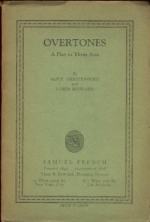|
This section contains 270 words (approx. 1 page at 400 words per page) |

|
Overtones is recognized as the first example of visually depicting the Freudian split between the id and the ego onstage. As W. David Sievers notes in Freud on Broadway, "it marks the first departure from realism for the purpose of dramatizing the unconscious." When the play premiered in 1915, it was a popular success and was "heralded as representing a new formula in theater," according to Beverly M. Matherne, writing in American Women Writers: A Critical Reference Guide from Colonial Times to the Present. The New York press did not give the play rave reviews, however. As Keith Newlin reports in his introduction to American Plays of the New Woman, the New York Times concentrated most of its critique on the other works presented on the same bill and only briefly noted of Overtones that its "idea was more clever than its execution." Newlin also notes, however...
|
This section contains 270 words (approx. 1 page at 400 words per page) |

|




